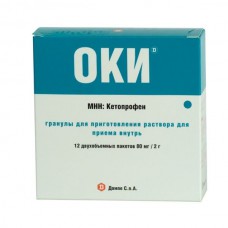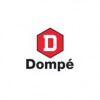Expiration date: 09/2026
The composition and form of issue:
Granules for preparation of oral solution 1 pack. two-volume
Ketoprofen lysine salt 80 mg
auxiliary substances: mannitol — 1700 mg of sodium chloride 132 mg colloidal silicon dioxide 3 mg of ammonium glycerate is 20 mg PVP 20 mg sodium saccharin 15 mg mint flavor — 30 mg
in two-volume bags of three-layer material of 2 g (half the dose — 1 g — in each volume ) in a cardboard box 12 or 20 bags.
Suppositories rectal for children 1 supp.
of a lysine salt of Ketoprofen 60 mg
excipients: semisynthetic glycerides-1020 mg
in strip of 5 PCs. in cardboard pack 2 strip.
Suppositories rectal 1 supp.
of a lysine salt of Ketoprofen 160 mg
auxiliary substances: semisynthetic glycerides — 1640 mg
in strip of 5 PCs. in cardboard pack 2 strip.
Solution for local application of 1 ml
of a lysine salt of Ketoprofen 16 mg
excipients: glycerol, 200 mg of ethanol — 0, 05 ml of methyl-p-hydroxybenzoate — 1, 5 mg flavor mint 3 mg menthol — 0, 7 mg sodium saccharin 2 mg "Certosa Verde" (green diamond) — 0, 16 mg of sodium hydrogen phosphate — 0, 022 g purified water to 1 ml
in bottles of 150 ml with a dispenser for injecting 2 ml of the drug and a plastic transparent lid for breeding with a capacity of 100 ml in a pack of cardboard 1 bottle.
Description of dosage form:
Granules for preparing a solution for oral administration: from white to pale yellow with a characteristic smell of mint.
Rectal suppositories for kids: from white to pale yellow torpedo-shaped.
Rectal suppositories from white to pale yellow torpedo-shaped.
Solution for topical application: transparent, green with a characteristic smell of mint.
Pharmacokinetics:
Suction. Appointed inside, Ketoprofen quickly and sufficiently absorbed from the digestive tract, its bioavailability is about 80%. Cmax in plasma by ingestion notes through 0, 5-2 h, its value is directly dependent on the dose after rectal application of Tmax is about 45-60 min. CSS Ketoprofen is achieved through 24 h after the start of regular intake.
Distribution. Up to 99% of absorbed Ketoprofen binds to plasma proteins, mainly albumin. Vd — 0, 1-0, 2 l/kg Easily passes through gistogematicalkie barriers and relate to tissues and organs. Ketoprofen well penetrates into synovial fluid and connective tissue. Although the concentration of Ketoprofen in synovial fluid is slightly lower than in plasma, it is more stable (up to 30 h).
Metabolism. Ketoprofen is mainly metabolized in the liver, where it undergoes glucuronidation to form esters with glucuronic acid.
After the use of 160 mg Ketoprofen lysine salt in the dosage form solution for topical use plasma concentration of Ketoprofen is low — less than 400 ng/ml — and therefore insufficient for pronounced systemic pharmacological action.
Description of the pharmacological action:
It has anti-inflammatory, analgesic and antipyretic effects. By inhibiting COX-1 and -2, inhibits the synthesis of GHGs. It has antibacterial activity, stabilizes lysosomal membranes and delays the release of enzymes from them, contributing to tissue destruction in chronic inflammation. Reduces the release of cytokines, inhibits the activity of neutrophils.
Reduces morning stiffness and swelling of the joints, increases the volume of movements.
Ketoprofen lysine salt, unlike Ketoprofen, is a rapidly soluble molecule with neutral pH and almost does not irritate the digestive tract.
Indications:
Granules for preparation of oral solution, rectal suppositories for children, rectal suppositories
Adult
Symptomatic treatment of inflammatory processes accompanied by heat and pain, including inflammatory and rheumatic joint diseases:
- rheumatoid arthritis
- spondylitises
- osteoarthrosis
- gouty arthritis
- inflammatory lesion of the periarticular tissues.
Children (over 6 years old)
Short-term symptomatic treatment of pain inflammatory processes in such conditions as:
- diseases of the musculoskeletal system
- otitis
- relief of postoperative pain.
Solution for topical application
Symptomatic treatment of inflammatory diseases of ENT organs and oral cavity:
- angina
- laryngitis
- pharyngitis
- tonsillitis
- stomatitis
- gingivitis
- glossitis
- aphthae
- paradontopathy
- chronic periodontal disease
- dental manipulations (as an analgesic).
Contraindications:
Common to all forms
- hypersensitivity (including to other NSAIDs)
- aspirin asthma.
Common for granules, rectal suppositories for children, rectal suppositories:
- peptic ulcer of the stomach and duodenum (exacerbation)
- ulcerative colitis (exacerbation)
- Crohn disease
- diverticulitis
- peptic ulcer
- hemophilia and other blood clotting disorders
- chronic renal failure
- children's age up to 6 years (for granules and suppositories rectal for children), for suppositories rectal - up to 18 years
- pregnancy (III trimester)
- lactation.
With caution:
- anemia
- bronchial asthma
- hyperbilirubinemia
- liver failure
- diabetes
- dehydration
- sepsis
- chronic heart failure
- edemas
- arterial hypertension
- blood disorders (including leukopenia)
- the deficit glukozo-6-fosfatdegidrogenaza
- stomatitis.
For rectal granules and suppositories additionally
With caution:
- alcoholism
- tobacco Smoking
- alcoholic cirrhosis
- old age
- pregnancy (I and II trimenon).
For solution for topical application
With caution:
- peptic ulcer of the stomach and duodenum (exacerbation)
- ulcerative colitis (exacerbation)
- Crohn disease
- diverticulitis
- peptic ulcer
- hemophilia and other blood clotting disorders
- chronic renal failure
- children's age (up to 6 years)
- pregnancy (III trimester)
- lactation.




